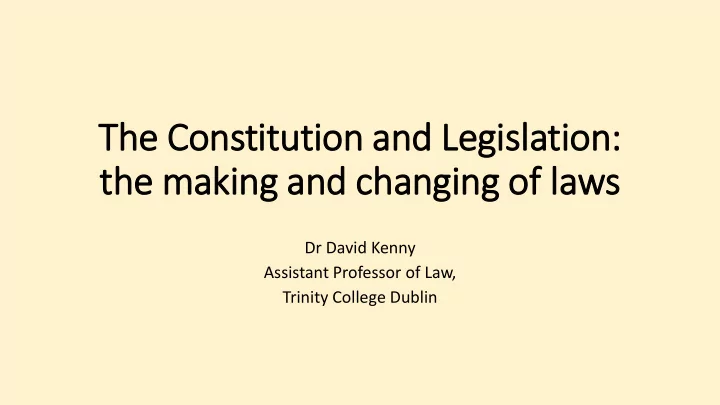

The Constitution and Legis islation: the making and changing of la laws Dr David Kenny Assistant Professor of Law, Trinity College Dublin
Constitution empowers law making, and also restrains it Article 15.2.1 of the Constitution: “ The sole and exclusive power of making laws for the State is hereby vested in the Oireachtas: no other legislative authority has power to make laws for the State.” 1. Law making power comes from the Constitution 2. The Oireachtas and only the Oireachtas makes law 3. A broad grant of power
Constitution empowers law making, and also restrains it But only insofar as the laws accord with the Constitution Article 15.4.1 of the Constitution: “ The Oireachtas shall not enact any law which is in any respect repugnant to this Constitution or any provision thereof.”
Three sorts of constitutional restraint on law making The Oireachtas must: 1. Follow constitutional process for making law 2. Not breach specific prohibitions in the Constitution Article 15.5: – Imposition of the death penalty 3. Not breach broader constitutional guarantees – personal rights, eg life, property, liberty, good name
How is a law made or changed? Housing Bill 2017 Step 1: Typically introduced by Minister in one House of the Oireachtas – usually the Dáil Goes through a five stage process where it is debated, in its broad principles and minute details Ends with a vote whereby the House passes or rejects the Bill
Housing Bill 2017 Step 2: Moves to the other House, the Seanad, and goes through the same 5 stages The Seanad can pass the Bill; reject the Bill; or return it to the Dáil with amendments Dáil can accept or reject amendments If Seanad rejects the Bill (which is very rare), Dáil can overrule the Seanad
Housing Bill 2017 Step 3: Sent to the President President must decide within 7 days to: - sign the Bill, and make it an Act and give it the force of law - refer it to the Supreme Court to test its constitutionality The President, like the Seanad, has no power to veto the Bill
Changing a law Changing a law is done by the same three step process – have to pass a new Act through both Houses, signed by the President An older law we need to change: - repeal the old law and replace it, or - amend the text of the old law to change its meaning and effect
Who controls the process? Government generally has significant control, because it usually has control of a majority of seats in the Houses of the Oireachtas - can control introduction of bills and their content - defeat any bills it doesn’t like - reject any amendments it disapproves of New developments have given more power back to Oireachtas - Pre-legislative scrutiny - Oireachtas committees discussing proposals for bills in early stages - Minority government – gives more power to Oireachtas over passage of bills
The Constitutionality of Laws What if there are constitutional questions about the Housing Bill 2017? - rent restrictions on landlords Three mechanisms to ensure constitutionality of laws: 1. Advice of Attorney General during drafting and passage of the Bill - only advice – not final and determinative - government will rarely proceed with legislation against Attorney General’s advice - Attorney General’s advice is not generally published
The Constitutionality of Laws 2. Reference of the Bill to the Supreme Court - If President requests it, Supreme Court will consider constitutionality of the entire Bill - If any provision is found to be unconstitutional, the Bill cannot be signed and does not become law - If the Bill survives, it is signed, and its constitutionality cannot be challenged again
The Constitutionality of Laws 3. Judicial review of the constitutionality of the Act - If the Bill is not referred to the Supreme Court, the Act can be challenged by citizens - A case taken in the High Court, and on appeal to Court of Appeal and Supreme Court - If Court is convinced by any of the arguments, it can invalidate any portion of the law that it finds to be unconstitutional - Generally, invalidated portion of the law is null and void, and can have no further force or effect
Changing the Constitution Constitutional amendments begin like any other bill: debated and passed by Dáil and Seanad (Seanad has no veto) But then approved by majority of voters in a referendum Only then can the President sign the Bill and the Constitution is amended
Recommend
More recommend